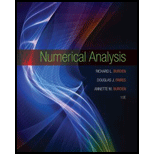
Concept explainers
- a. Use Algorithm 3.2 to construct the interpolating polynomial of degree four for the unequally spaced points given in the following table:

- b. Add f(1.1) = −3.99583 to the table and construct the interpolating polynomial of degree five.
ALGORITHM 3.2
Newton’s Divided-Difference Formula
To obtain the divided-difference coefficients of the interpolatory polynomial P on the (n + 1) distinct numbers x0, x1, … xn, for the function f:
INPUT numbers x0, x1, … xn; values f(x0), f(x1), …, f(xn) as F0,0, F1,0, …, Fn,0.
OUTPUT the numbers F0,0, F1,1, …, Fn,n where
Step 1 For i = 1, 2, …, n
For j = 1, 2, …, i
set
Step 2 OUTPUT (F0,0, F1,1, …, Fn,n);
STOP.
Want to see the full answer?
Check out a sample textbook solution
Chapter 3 Solutions
Numerical Analysis
- A polynomial of degree n I has exactly ____________________zero if a zero of multiplicity m is counted m times.arrow_forwardWhen we divide a polynomial P(x) by a divisor D(x), the Division Algorithm tells us that we can always obtain a quotient Q(x) and a remainder R(x). State two forms in which the result of this division can be written.arrow_forward31. Prove statement of Theorem : for all integers and .arrow_forward
- Algebra & Trigonometry with Analytic GeometryAlgebraISBN:9781133382119Author:SwokowskiPublisher:Cengage
 College AlgebraAlgebraISBN:9781305115545Author:James Stewart, Lothar Redlin, Saleem WatsonPublisher:Cengage Learning
College AlgebraAlgebraISBN:9781305115545Author:James Stewart, Lothar Redlin, Saleem WatsonPublisher:Cengage Learning Elements Of Modern AlgebraAlgebraISBN:9781285463230Author:Gilbert, Linda, JimmiePublisher:Cengage Learning,
Elements Of Modern AlgebraAlgebraISBN:9781285463230Author:Gilbert, Linda, JimmiePublisher:Cengage Learning,  Linear Algebra: A Modern IntroductionAlgebraISBN:9781285463247Author:David PoolePublisher:Cengage Learning
Linear Algebra: A Modern IntroductionAlgebraISBN:9781285463247Author:David PoolePublisher:Cengage Learning



